Count St. Nuno Álvares Pereira, Constable of Portugal
NUNO ÁLVARES PEREIRA was born in Portugal on 24th June 1360, most probably at Cernache do Bomjardin, illegitimate son of Brother Álvaro Gonçalves Pereira, Hospitalier Knight of St. John of Jerusalem and prior of Crato and Donna Iria Gonçalves do Carvalhal. About a year after his birth, the child was legitimized by royal decree and so was able to receive a knightly education typical of the offspring of the noble families of the time.
At thirteen years of age he became page to Queen Leonor, was received at court and was created a knight. At sixteen years of age, at the wish of his father, he married a rich young widow Donna Leonor de Alvim. Three children were born to the union, two boys who died early in life, and a girl, Beatrice, who would eventually marry Afonso, first Duke of Bragança, son of King João I.
When King Fernando died, without an heir on 22nd October 1383, his brother João, became involved in the struggle to win the Lusitanian crown, which was being contested by the King of Castile, who had married the daughter of the dead king. Nuno took João’s side. He wanted him as his constable, that is commander-in-chief of the army. Nuno led the Portuguese army to victory on various occasions up until the battle of Aljubarrota (14th August 1385), which brought the conflict to an end.
Lithograph by Charles Legrand of St. Nuno Álvares Pereira.
The military capabilities of Nuno were, nevertheless, tempered by a deep spirituality, a profound love of the Eucharist and of the Blessed Virgin, the main foundations of his interior life. Totally dedicated to Marian prayer, he fasted in Mary’s honour on Wednesdays, Fridays and Saturdays and on the vigil of her feasts. The banner he chose as his personal standard bore the image of the cross, of Mary and of the saintly knights James and George. At his own expense he built numerous churches and monasteries, among which was the Carmelite church in Lisbon and the church of Our Lady of Victories at Batalha.
Equestrian statue of St. Nuno Alvares Pereira at the Monastery of Batalha, Portugal
Following the death of his wife in 1387, Nuno did not wish to marry again and became a model of celibate life. When peace finally came, he gave the bulk of his wealth to the veterans, the rest he would dispose of in 1423 when he decided to enter the convent of the Carmelites which he himself had founded, taking the name of Brother Nuno of Saint Mary. Animated by love he abandoned power to serve the poor: it was a radical choice for a life, bringing as it did to a high point, the authentic path of faith which he had always followed. With this choice, he left behind the weapons of war and power in order to be vested in spiritual armor as the Rule of Carmel recommends.
He would have wanted to withdraw to a community far away from Portugal, but the son of the king, Don Duarte, prevented it. No power could stop him from dedicating himself to the convent and above all to the poor, whom he continued to help and serve in every possible way. For them he organized a daily distribution of food and never hesitated in responding to their needs. The Commander of the King of Portugal, chief officer of the army and victorious leader, founder and benefactor of the Carmelite community, when entering the convent did not want any privileges but chose the humblest rank of a lay brother, putting himself at the service of the Lord, of Mary his ever venerated Patron, and of the poor in whom he recognized the face of Jesus himself.
St. Nuno receiving the Carmelite habit and the Religious name of Friar Nuno of Saint Mary.
Of significance too was the day of the death of Brother Nuno of Saint Mary: it was Easter Sunday, the 1st April 1431, and what following it was that he was immediately acclaimed a saint by the people who called him “O Santo Condestavel” [Holy Constable].
_______________________________________________
Written by Benjamin Hiegert
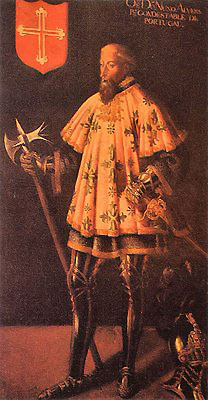
Count Saint Nuno Alvares Pereira
Portuguese Count Nuno Alvares Pereira had a brilliant military career and became the Constable of Portugal. Later, out of gratitude for a miraculous victory he won over the Spaniards, Saint Nuno built the Gothic church of Our Lady of the Scapular of Mount Carmel on a hill outside of Lisbon. He gave the church to the Carmelite order, and then joined them as a simple lay brother.
Saint Nuno’s combative life and his devotion serve as an example for Catholics today who must fight to affirm their Faith in a secular world. As we will see, he drew his strength for the fight from his great devotion to Our Lady.
Saint Nuno was born and grew up outside Ourem near Fatima where Our Lady appeared in 1917, and from his youth, he had an ardent devotion to her, the Rosary and to the Brown Scapular.
During the 14th century, Portugal had nearly become a province of the Kingdom of Castile. Spain had already defeated Portugal’s armies, and the Portuguese court was weak and decadent. Most of Saint Nuno’s life was spent fighting the Spanish to preserve Portuguese independence. His most important battles were Atoleiros, Aljubarrota (very near Fatima), and Valverde inside of Spain.*
The Battle of Atoleiros
When John I was proclaimed king of Portugal, a Castilian army immediately entered the Portuguese provinces south of Lisbon. King John asked Count Nuno to put together an army to face the Spaniards, which he quickly did. By the time Count Nuno reached Estremoz, he had 300 horsemen and 1000 infantrymen. The Castilians had 5000 soldiers commanded by their best captains. Count Nuno realized the danger of his situation and also that the greatest danger was discouragement, so he gave a short speech saying that if the Castilians were many, the more honor there would be for the Portuguese. He told anyone who was afraid to leave before the battle. Not one abandoned him.The Holy Count had to adopt novel tactics at the battle of Atoleiros because of the odds. He formed his cavalry into a square and surrounded the outer edges with infantry holding lances. Behind each lancer, there was another man ready to pick up the lance if the first lancer were wounded or killed. Count Nuno rode in the middle of the square, giving orders and encouraging everyone. Immediately before the battle, he spoke again to his soldiers, and then jumped off his horse and knelt before his banner that had Our Lady at the foot of the Cross on one side and the Nativity on the other. The whole Portuguese army followed suit, and knelt and prayed before the standard. When they heard the roar of the advancing Castilian army, Count Nuno leapt onto his horse. The Portuguese responded to the Castilian war cry with “Portugal! Saint George!”
The Castilians thought the poorly armed Portuguese cavalry would not withstand the cavalry charge. They were so sure of this that they advanced without a plan. Upon the first impact, the Castilian horses were impaled upon the row of lances. Then the Portuguese rained arrows on the Castilian troops that were behind the stalled cavalry. Confusion, and then terror, spread through the Castilian ranks. The Castilian soldiers saw many of their leaders dead and began to flee. Count Nuno ordered the cavalry to give chase. Without the protection of their own cavalry, the Castilian soldiers did not stand a chance.
This was the first Portuguese victory under the new king, and the victory gave him time to unite the country and prepare for the larger attack.
The day after the tremendous victory of Atoleiros, Count Nuno made a six-mile pilgrimage barefoot, over cobblestones and rough terrain, to a nearby shrine of Our Lady in thanksgiving for her help. Upon arriving at the shrine, he found it dirty and profaned. The Castilians had quartered their horses in the church! With his own hands, he cleaned out the church and vowed to build an even more awesome shrine in her honor.
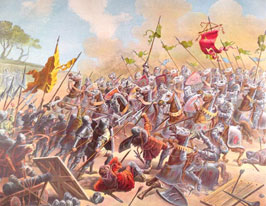
The Battle of Aljubarotta
The Battle of Aljubarotta
Despite several Portuguese victories, Castile continued to attack. Now, an army of 30,000 strong invaded Portugal and used scorched-earth tactics.
Count Nuno rushed with his army to the area outside of Leiria. Everyone knew this was to be the great, decisive battle of the war. When his cavalry arrived ahead of schedule at Aljubarotta, the king of Castile thought he found his chance to take Count Nuno off guard and kill him.
It was August 14, 1385, the eve of the feast of Our Lady’s Assumption, and the Portuguese army was fasting in preparation for the feast. Once again, Count Nuno had a much smaller army, this time 8,000 Portuguese. The two armies maneuvered throughout the day to get into favorable positions. Once again, the Castilian cavalry charged into the Portuguese square formation. This time they almost broke through, but Count Nuno ordered the Portuguese cavalry he held in reserve on the flanks to attack. This saved the Portuguese square, but the situation was desperate.
The king of Castile ordered his reserves to attack, but they hesitated. In vain, the Castilian nobles tried to push them to the attack, but the troops in the rear began to flee. The Castilian king’s last option was to order another cavalry force to charge the Portuguese from the rear. Count Nuno, however, saw this coming and had a wall of lances ready to face the charge. After more brutal hand-to-hand fighting, the Castilian force also fled. Just then the main body of the Castilian infantry arrived at the battlefield. They retreated in disorder with the others to Leiria.
Out of gratitude for this great victory, King John built the great Gothic monastery of Batalha.
The Battle of Valverde
Next, the Portuguese army split in two. King John took half the army to northern Portugal to expel the Spaniards and the Holy Count went to the south. From the Spanish border, Count Nuno sent a message to the king of Castile that if he did not immediately recognize Portugal as an independent kingdom, he then would take the battle to Spanish soil. Count Nuno entered Spain and took control of several cities. He again divided his army, taking only about 300 knights to the Castilian camp. He hoped to lure the Castilians into a battle and then have the rest of his army launch a surprise attack. The Spaniards were in a strong strategic position on a hill across the river from Nuno and his men. The Spaniards sent half of their army to circle behind the Portuguese to attack from the rear. The prospects were grimmer than Atoleiros and Aljubarotta, and Count Nuno prayed as never before.
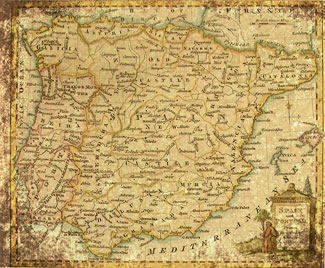
A map of medieval Portugal and Spain
His men were in the square formation and advanced toward the hill held by the Castilians. He hoped to take that hill, and then turn to face the other half of the Castilian army. As soon as the Portuguese crossed the river, the Castilians attacked. Once again, Count Nuno was everywhere, shouting orders and words of encouragement to the soldiers. Then, he heard cries from the rear of the square as the other half of the Castilian army attacked. A dart wounded Count Nuno, but he ignored the pain and continued fighting. As the Castilian army pressed the attack on the vanguard, Count Nuno’s men called out for him, but he was nowhere to be found. A wave of panic swept through the Portuguese. Where was Nuno Alvarez? Had he been killed?Then, an officer found Count Nuno, kneeling in prayer between two huge rocks. He was holding a reliquary containing a thorn from Our Lord’s Crown of Thorns. The officer cried out in despair, “We are lost!” Count Nuno responded, “My friend, it is not yet time. Wait a bit.” And he continued to pray. Then after a few moments, Count Nuno picked up his helmet and rose to his feet. He mounted his horse, and pointed out to his standard bearer the Master of Santiago who was at the top of the hill. “We must go up there with my standard!” Then leading the way and shouting “Forward! Forward!” to his men, Count Nuno advanced. To the Portuguese, it seemed almost a resurrection. The Portuguese soldiers surged forward with Count Nuno while the Castilians gave way. The Castilian army was so badly beaten there was no counterattack. With this victory of the battle of Valverde, Castile gave up subduing Portugal.
The Carmelite Constable

St. Nuno in the habit of a Carmelite donato.
Out of gratitude for the victory at Valverde, Count Nuno began construction of the shrine and monastery of Our Lady of the Scapular of Mount Carmel in Lisbon. This magnificent Gothic church was built on a hill outside Lisbon. Upon completion, Count Nuno wrote the Carmelite superior and asked the monks to take care of the shrine and to establish a monastery there. Meanwhile, Count Nuno made arrangements for his property, setting aside a third for his grandchildren, a third for the poor and a third for his retirement. Then, he knocked on the door of the Carmelite monastery and asked the prior for permission to join the order as a type of lay brother called a donato. The prior was shocked but finally accepted Nuno. As a donato, he would be the lowest one at the monastery, and he would only take simple vows as opposed to solemn perpetual vows. Thus, he could leave the monastery to lead an army if Portugal were attacked.King John was dismayed at the count’s decision. He sent his son Duarte to convince Nuno to give up, saying the enemies of Portugal would take advantage to attack. Count Nuno pulled aside the scapular of his habit and exposed the armor he wore underneath the Carmelite habit. He told Duarte to tell the king he was ready to come to the aid of his country whenever needed. The Castilians also were curious. Since it was time to sign the peace treaty, the Castilian ambassador visited Nuno in the monastery. He could not believe Portugal’s great hero had become a simple monk. Again, Nuno uncovered the armor beneath his habit and warned them not to attack Portugal.After eight years in the monastery, Nuno Alvares Pereira died on Easter Sunday of 1431. His life of fight and of faith in opposition to the world that was abandoning the Christ-centered spirit of the Middle Ages can serve as a guide for those who want to be faithful and to fight for the Church and Christian civilization in these turbulent times.
__________________
* For an account of Saint Nuno Alvarez Pereira’s life, see John Haffert, The Peacemaker Who Went to War: The Life of Blessed Nun’Alvarez Pereira, Precursor of Our Lady of Fatima.

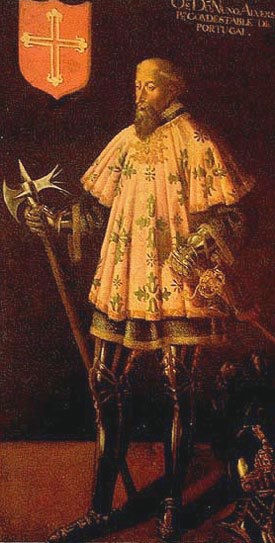

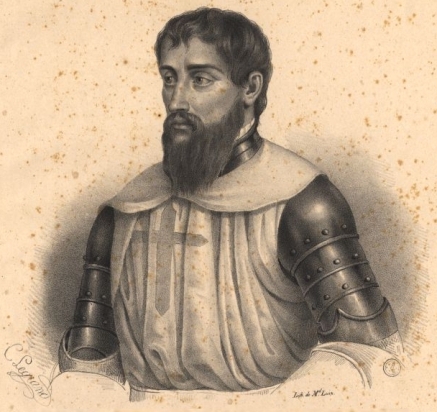
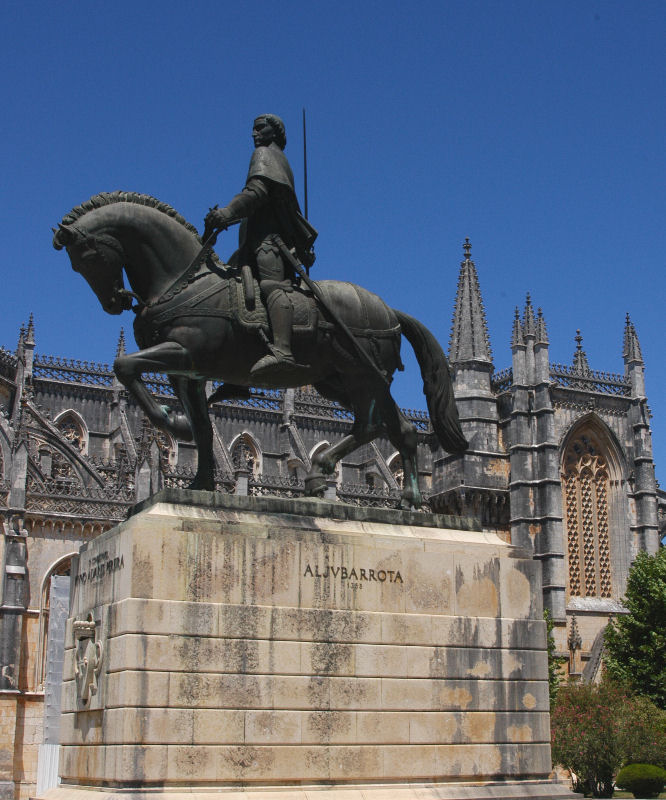
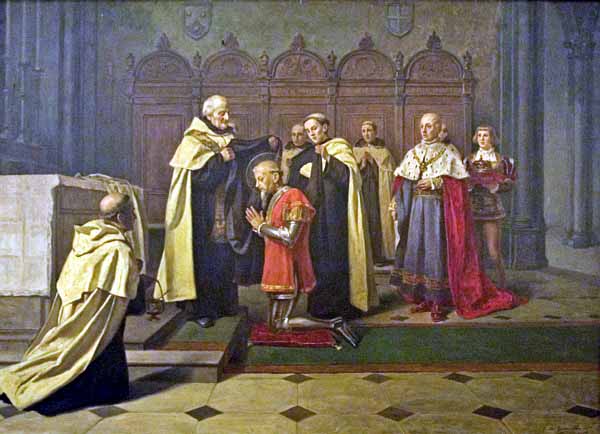
No comments:
Post a Comment